Property Law: Caveats, Easements, Contract Cancellation Analysis
VerifiedAdded on 2020/04/13
|11
|4679
|100
Report
AI Summary
This report examines three key areas of property law: caveats, easements, and contract cancellation, providing a detailed analysis of each. The first section addresses the issue of caveats, discussing how they can protect property owners and the legal avenues available for their removal, including court actions based on cases like Swaston Mortgage Pty Ltd v. Trepan investment Pty Ltd. The report then delves into the rights of purchasers and vendors in property contracts, considering the legality of contract cancellations, the impact of property conditions, and the role of consumer protection laws. Finally, the report explores easements, outlining legal treatments, dispute resolution mechanisms, and the conditions under which easements can be withdrawn, referencing cases like Hanny and Anor v Lewis and Ors. The report provides a comprehensive overview of these property law topics, including relevant legal cases and the rights of involved parties.

Name:
Course:
Professor:
Date:
Course:
Professor:
Date:
Paraphrase This Document
Need a fresh take? Get an instant paraphrase of this document with our AI Paraphraser
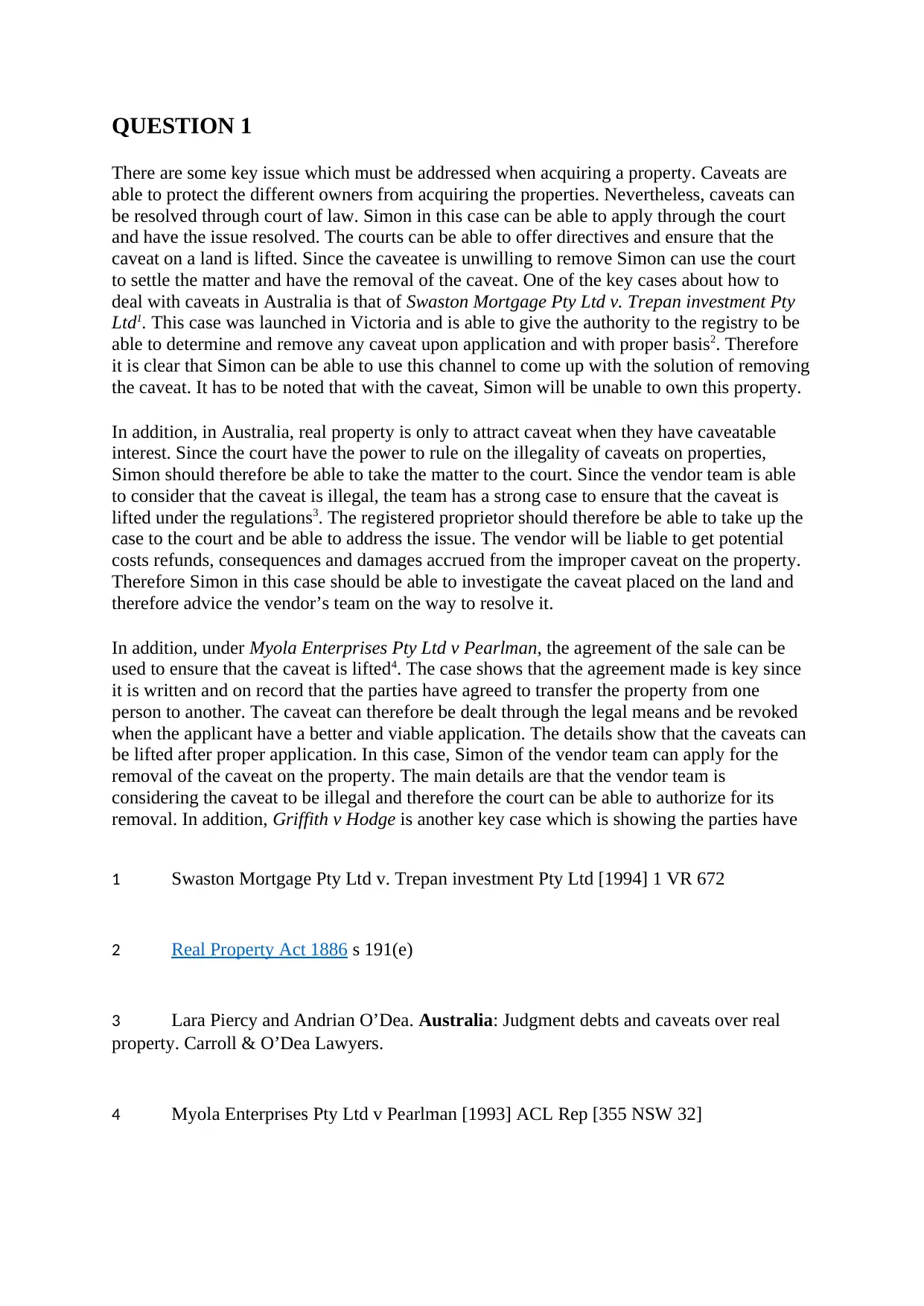
QUESTION 1
There are some key issue which must be addressed when acquiring a property. Caveats are
able to protect the different owners from acquiring the properties. Nevertheless, caveats can
be resolved through court of law. Simon in this case can be able to apply through the court
and have the issue resolved. The courts can be able to offer directives and ensure that the
caveat on a land is lifted. Since the caveatee is unwilling to remove Simon can use the court
to settle the matter and have the removal of the caveat. One of the key cases about how to
deal with caveats in Australia is that of Swaston Mortgage Pty Ltd v. Trepan investment Pty
Ltd1. This case was launched in Victoria and is able to give the authority to the registry to be
able to determine and remove any caveat upon application and with proper basis2. Therefore
it is clear that Simon can be able to use this channel to come up with the solution of removing
the caveat. It has to be noted that with the caveat, Simon will be unable to own this property.
In addition, in Australia, real property is only to attract caveat when they have caveatable
interest. Since the court have the power to rule on the illegality of caveats on properties,
Simon should therefore be able to take the matter to the court. Since the vendor team is able
to consider that the caveat is illegal, the team has a strong case to ensure that the caveat is
lifted under the regulations3. The registered proprietor should therefore be able to take up the
case to the court and be able to address the issue. The vendor will be liable to get potential
costs refunds, consequences and damages accrued from the improper caveat on the property.
Therefore Simon in this case should be able to investigate the caveat placed on the land and
therefore advice the vendor’s team on the way to resolve it.
In addition, under Myola Enterprises Pty Ltd v Pearlman, the agreement of the sale can be
used to ensure that the caveat is lifted4. The case shows that the agreement made is key since
it is written and on record that the parties have agreed to transfer the property from one
person to another. The caveat can therefore be dealt through the legal means and be revoked
when the applicant have a better and viable application. The details show that the caveats can
be lifted after proper application. In this case, Simon of the vendor team can apply for the
removal of the caveat on the property. The main details are that the vendor team is
considering the caveat to be illegal and therefore the court can be able to authorize for its
removal. In addition, Griffith v Hodge is another key case which is showing the parties have
1 Swaston Mortgage Pty Ltd v. Trepan investment Pty Ltd [1994] 1 VR 672
2 Real Property Act 1886 s 191(e)
3 Lara Piercy and Andrian O’Dea. Australia: Judgment debts and caveats over real
property. Carroll & O’Dea Lawyers.
4 Myola Enterprises Pty Ltd v Pearlman [1993] ACL Rep [355 NSW 32]
There are some key issue which must be addressed when acquiring a property. Caveats are
able to protect the different owners from acquiring the properties. Nevertheless, caveats can
be resolved through court of law. Simon in this case can be able to apply through the court
and have the issue resolved. The courts can be able to offer directives and ensure that the
caveat on a land is lifted. Since the caveatee is unwilling to remove Simon can use the court
to settle the matter and have the removal of the caveat. One of the key cases about how to
deal with caveats in Australia is that of Swaston Mortgage Pty Ltd v. Trepan investment Pty
Ltd1. This case was launched in Victoria and is able to give the authority to the registry to be
able to determine and remove any caveat upon application and with proper basis2. Therefore
it is clear that Simon can be able to use this channel to come up with the solution of removing
the caveat. It has to be noted that with the caveat, Simon will be unable to own this property.
In addition, in Australia, real property is only to attract caveat when they have caveatable
interest. Since the court have the power to rule on the illegality of caveats on properties,
Simon should therefore be able to take the matter to the court. Since the vendor team is able
to consider that the caveat is illegal, the team has a strong case to ensure that the caveat is
lifted under the regulations3. The registered proprietor should therefore be able to take up the
case to the court and be able to address the issue. The vendor will be liable to get potential
costs refunds, consequences and damages accrued from the improper caveat on the property.
Therefore Simon in this case should be able to investigate the caveat placed on the land and
therefore advice the vendor’s team on the way to resolve it.
In addition, under Myola Enterprises Pty Ltd v Pearlman, the agreement of the sale can be
used to ensure that the caveat is lifted4. The case shows that the agreement made is key since
it is written and on record that the parties have agreed to transfer the property from one
person to another. The caveat can therefore be dealt through the legal means and be revoked
when the applicant have a better and viable application. The details show that the caveats can
be lifted after proper application. In this case, Simon of the vendor team can apply for the
removal of the caveat on the property. The main details are that the vendor team is
considering the caveat to be illegal and therefore the court can be able to authorize for its
removal. In addition, Griffith v Hodge is another key case which is showing the parties have
1 Swaston Mortgage Pty Ltd v. Trepan investment Pty Ltd [1994] 1 VR 672
2 Real Property Act 1886 s 191(e)
3 Lara Piercy and Andrian O’Dea. Australia: Judgment debts and caveats over real
property. Carroll & O’Dea Lawyers.
4 Myola Enterprises Pty Ltd v Pearlman [1993] ACL Rep [355 NSW 32]
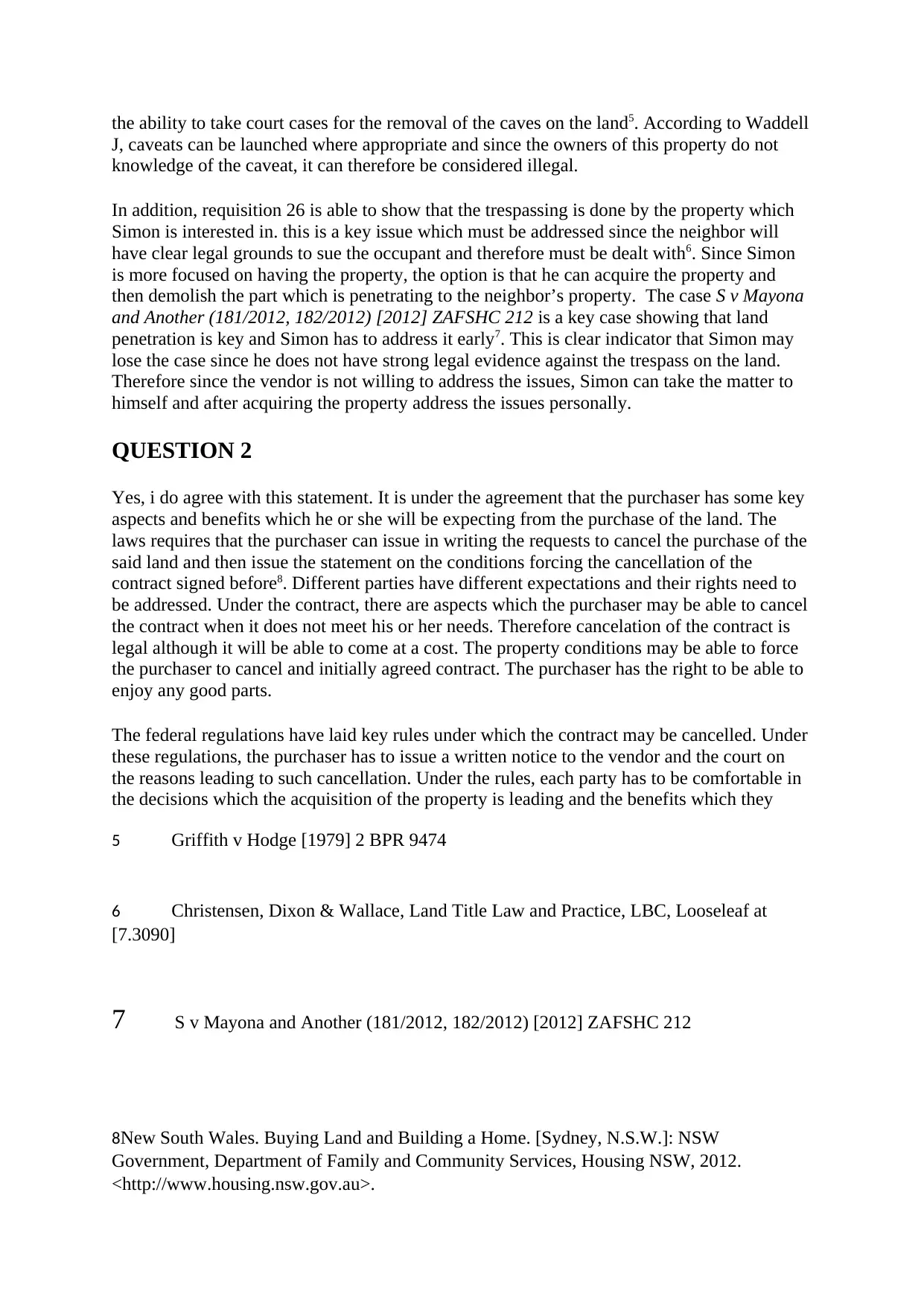
the ability to take court cases for the removal of the caves on the land5. According to Waddell
J, caveats can be launched where appropriate and since the owners of this property do not
knowledge of the caveat, it can therefore be considered illegal.
In addition, requisition 26 is able to show that the trespassing is done by the property which
Simon is interested in. this is a key issue which must be addressed since the neighbor will
have clear legal grounds to sue the occupant and therefore must be dealt with6. Since Simon
is more focused on having the property, the option is that he can acquire the property and
then demolish the part which is penetrating to the neighbor’s property. The case S v Mayona
and Another (181/2012, 182/2012) [2012] ZAFSHC 212 is a key case showing that land
penetration is key and Simon has to address it early7. This is clear indicator that Simon may
lose the case since he does not have strong legal evidence against the trespass on the land.
Therefore since the vendor is not willing to address the issues, Simon can take the matter to
himself and after acquiring the property address the issues personally.
QUESTION 2
Yes, i do agree with this statement. It is under the agreement that the purchaser has some key
aspects and benefits which he or she will be expecting from the purchase of the land. The
laws requires that the purchaser can issue in writing the requests to cancel the purchase of the
said land and then issue the statement on the conditions forcing the cancellation of the
contract signed before8. Different parties have different expectations and their rights need to
be addressed. Under the contract, there are aspects which the purchaser may be able to cancel
the contract when it does not meet his or her needs. Therefore cancelation of the contract is
legal although it will be able to come at a cost. The property conditions may be able to force
the purchaser to cancel and initially agreed contract. The purchaser has the right to be able to
enjoy any good parts.
The federal regulations have laid key rules under which the contract may be cancelled. Under
these regulations, the purchaser has to issue a written notice to the vendor and the court on
the reasons leading to such cancellation. Under the rules, each party has to be comfortable in
the decisions which the acquisition of the property is leading and the benefits which they
5 Griffith v Hodge [1979] 2 BPR 9474
6 Christensen, Dixon & Wallace, Land Title Law and Practice, LBC, Looseleaf at
[7.3090]
7 S v Mayona and Another (181/2012, 182/2012) [2012] ZAFSHC 212
8New South Wales. Buying Land and Building a Home. [Sydney, N.S.W.]: NSW
Government, Department of Family and Community Services, Housing NSW, 2012.
<http://www.housing.nsw.gov.au>.
J, caveats can be launched where appropriate and since the owners of this property do not
knowledge of the caveat, it can therefore be considered illegal.
In addition, requisition 26 is able to show that the trespassing is done by the property which
Simon is interested in. this is a key issue which must be addressed since the neighbor will
have clear legal grounds to sue the occupant and therefore must be dealt with6. Since Simon
is more focused on having the property, the option is that he can acquire the property and
then demolish the part which is penetrating to the neighbor’s property. The case S v Mayona
and Another (181/2012, 182/2012) [2012] ZAFSHC 212 is a key case showing that land
penetration is key and Simon has to address it early7. This is clear indicator that Simon may
lose the case since he does not have strong legal evidence against the trespass on the land.
Therefore since the vendor is not willing to address the issues, Simon can take the matter to
himself and after acquiring the property address the issues personally.
QUESTION 2
Yes, i do agree with this statement. It is under the agreement that the purchaser has some key
aspects and benefits which he or she will be expecting from the purchase of the land. The
laws requires that the purchaser can issue in writing the requests to cancel the purchase of the
said land and then issue the statement on the conditions forcing the cancellation of the
contract signed before8. Different parties have different expectations and their rights need to
be addressed. Under the contract, there are aspects which the purchaser may be able to cancel
the contract when it does not meet his or her needs. Therefore cancelation of the contract is
legal although it will be able to come at a cost. The property conditions may be able to force
the purchaser to cancel and initially agreed contract. The purchaser has the right to be able to
enjoy any good parts.
The federal regulations have laid key rules under which the contract may be cancelled. Under
these regulations, the purchaser has to issue a written notice to the vendor and the court on
the reasons leading to such cancellation. Under the rules, each party has to be comfortable in
the decisions which the acquisition of the property is leading and the benefits which they
5 Griffith v Hodge [1979] 2 BPR 9474
6 Christensen, Dixon & Wallace, Land Title Law and Practice, LBC, Looseleaf at
[7.3090]
7 S v Mayona and Another (181/2012, 182/2012) [2012] ZAFSHC 212
8New South Wales. Buying Land and Building a Home. [Sydney, N.S.W.]: NSW
Government, Department of Family and Community Services, Housing NSW, 2012.
<http://www.housing.nsw.gov.au>.
⊘ This is a preview!⊘
Do you want full access?
Subscribe today to unlock all pages.

Trusted by 1+ million students worldwide
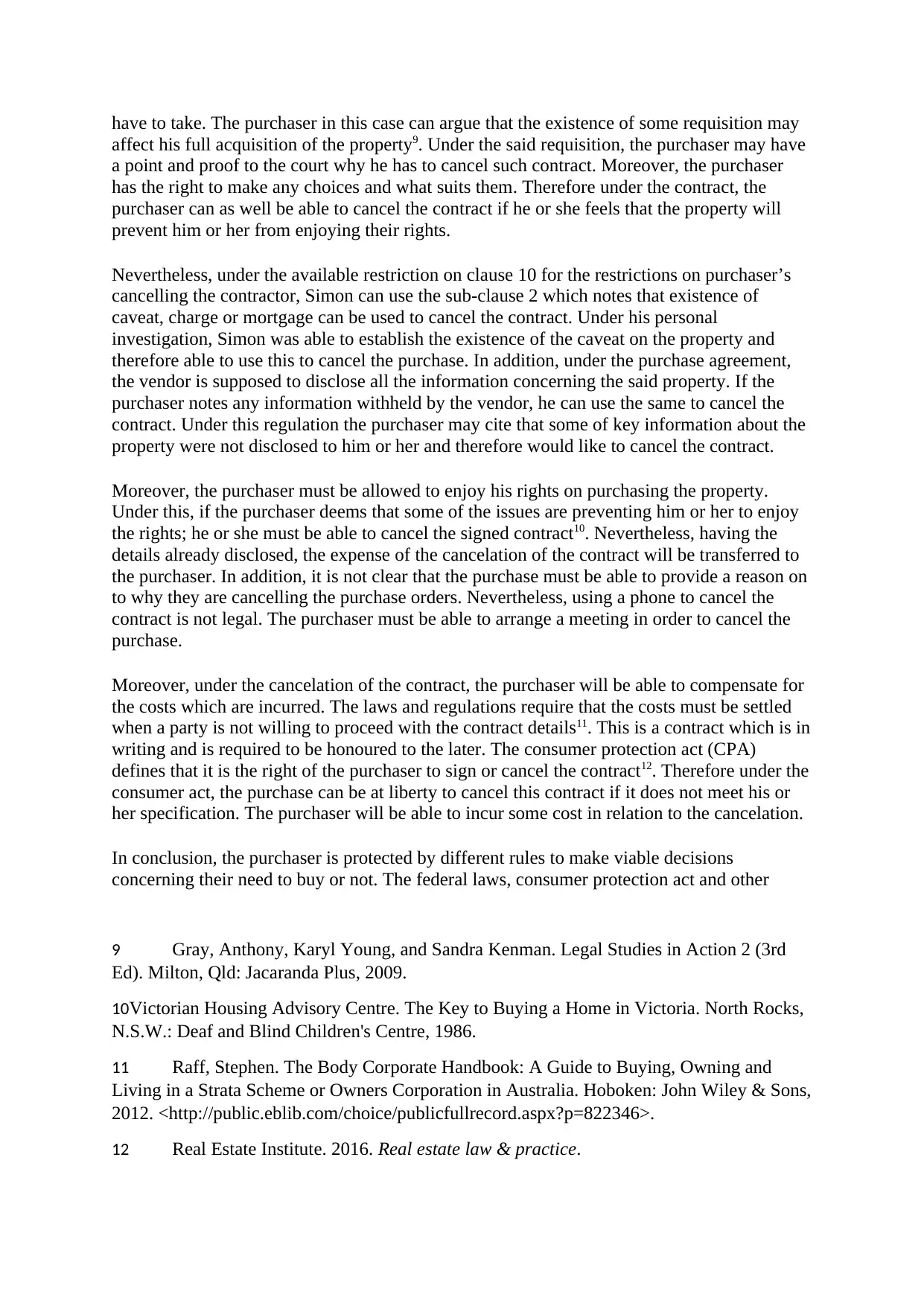
have to take. The purchaser in this case can argue that the existence of some requisition may
affect his full acquisition of the property9. Under the said requisition, the purchaser may have
a point and proof to the court why he has to cancel such contract. Moreover, the purchaser
has the right to make any choices and what suits them. Therefore under the contract, the
purchaser can as well be able to cancel the contract if he or she feels that the property will
prevent him or her from enjoying their rights.
Nevertheless, under the available restriction on clause 10 for the restrictions on purchaser’s
cancelling the contractor, Simon can use the sub-clause 2 which notes that existence of
caveat, charge or mortgage can be used to cancel the contract. Under his personal
investigation, Simon was able to establish the existence of the caveat on the property and
therefore able to use this to cancel the purchase. In addition, under the purchase agreement,
the vendor is supposed to disclose all the information concerning the said property. If the
purchaser notes any information withheld by the vendor, he can use the same to cancel the
contract. Under this regulation the purchaser may cite that some of key information about the
property were not disclosed to him or her and therefore would like to cancel the contract.
Moreover, the purchaser must be allowed to enjoy his rights on purchasing the property.
Under this, if the purchaser deems that some of the issues are preventing him or her to enjoy
the rights; he or she must be able to cancel the signed contract10. Nevertheless, having the
details already disclosed, the expense of the cancelation of the contract will be transferred to
the purchaser. In addition, it is not clear that the purchase must be able to provide a reason on
to why they are cancelling the purchase orders. Nevertheless, using a phone to cancel the
contract is not legal. The purchaser must be able to arrange a meeting in order to cancel the
purchase.
Moreover, under the cancelation of the contract, the purchaser will be able to compensate for
the costs which are incurred. The laws and regulations require that the costs must be settled
when a party is not willing to proceed with the contract details11. This is a contract which is in
writing and is required to be honoured to the later. The consumer protection act (CPA)
defines that it is the right of the purchaser to sign or cancel the contract12. Therefore under the
consumer act, the purchase can be at liberty to cancel this contract if it does not meet his or
her specification. The purchaser will be able to incur some cost in relation to the cancelation.
In conclusion, the purchaser is protected by different rules to make viable decisions
concerning their need to buy or not. The federal laws, consumer protection act and other
9 Gray, Anthony, Karyl Young, and Sandra Kenman. Legal Studies in Action 2 (3rd
Ed). Milton, Qld: Jacaranda Plus, 2009.
10Victorian Housing Advisory Centre. The Key to Buying a Home in Victoria. North Rocks,
N.S.W.: Deaf and Blind Children's Centre, 1986.
11 Raff, Stephen. The Body Corporate Handbook: A Guide to Buying, Owning and
Living in a Strata Scheme or Owners Corporation in Australia. Hoboken: John Wiley & Sons,
2012. <http://public.eblib.com/choice/publicfullrecord.aspx?p=822346>.
12 Real Estate Institute. 2016. Real estate law & practice.
affect his full acquisition of the property9. Under the said requisition, the purchaser may have
a point and proof to the court why he has to cancel such contract. Moreover, the purchaser
has the right to make any choices and what suits them. Therefore under the contract, the
purchaser can as well be able to cancel the contract if he or she feels that the property will
prevent him or her from enjoying their rights.
Nevertheless, under the available restriction on clause 10 for the restrictions on purchaser’s
cancelling the contractor, Simon can use the sub-clause 2 which notes that existence of
caveat, charge or mortgage can be used to cancel the contract. Under his personal
investigation, Simon was able to establish the existence of the caveat on the property and
therefore able to use this to cancel the purchase. In addition, under the purchase agreement,
the vendor is supposed to disclose all the information concerning the said property. If the
purchaser notes any information withheld by the vendor, he can use the same to cancel the
contract. Under this regulation the purchaser may cite that some of key information about the
property were not disclosed to him or her and therefore would like to cancel the contract.
Moreover, the purchaser must be allowed to enjoy his rights on purchasing the property.
Under this, if the purchaser deems that some of the issues are preventing him or her to enjoy
the rights; he or she must be able to cancel the signed contract10. Nevertheless, having the
details already disclosed, the expense of the cancelation of the contract will be transferred to
the purchaser. In addition, it is not clear that the purchase must be able to provide a reason on
to why they are cancelling the purchase orders. Nevertheless, using a phone to cancel the
contract is not legal. The purchaser must be able to arrange a meeting in order to cancel the
purchase.
Moreover, under the cancelation of the contract, the purchaser will be able to compensate for
the costs which are incurred. The laws and regulations require that the costs must be settled
when a party is not willing to proceed with the contract details11. This is a contract which is in
writing and is required to be honoured to the later. The consumer protection act (CPA)
defines that it is the right of the purchaser to sign or cancel the contract12. Therefore under the
consumer act, the purchase can be at liberty to cancel this contract if it does not meet his or
her specification. The purchaser will be able to incur some cost in relation to the cancelation.
In conclusion, the purchaser is protected by different rules to make viable decisions
concerning their need to buy or not. The federal laws, consumer protection act and other
9 Gray, Anthony, Karyl Young, and Sandra Kenman. Legal Studies in Action 2 (3rd
Ed). Milton, Qld: Jacaranda Plus, 2009.
10Victorian Housing Advisory Centre. The Key to Buying a Home in Victoria. North Rocks,
N.S.W.: Deaf and Blind Children's Centre, 1986.
11 Raff, Stephen. The Body Corporate Handbook: A Guide to Buying, Owning and
Living in a Strata Scheme or Owners Corporation in Australia. Hoboken: John Wiley & Sons,
2012. <http://public.eblib.com/choice/publicfullrecord.aspx?p=822346>.
12 Real Estate Institute. 2016. Real estate law & practice.
Paraphrase This Document
Need a fresh take? Get an instant paraphrase of this document with our AI Paraphraser
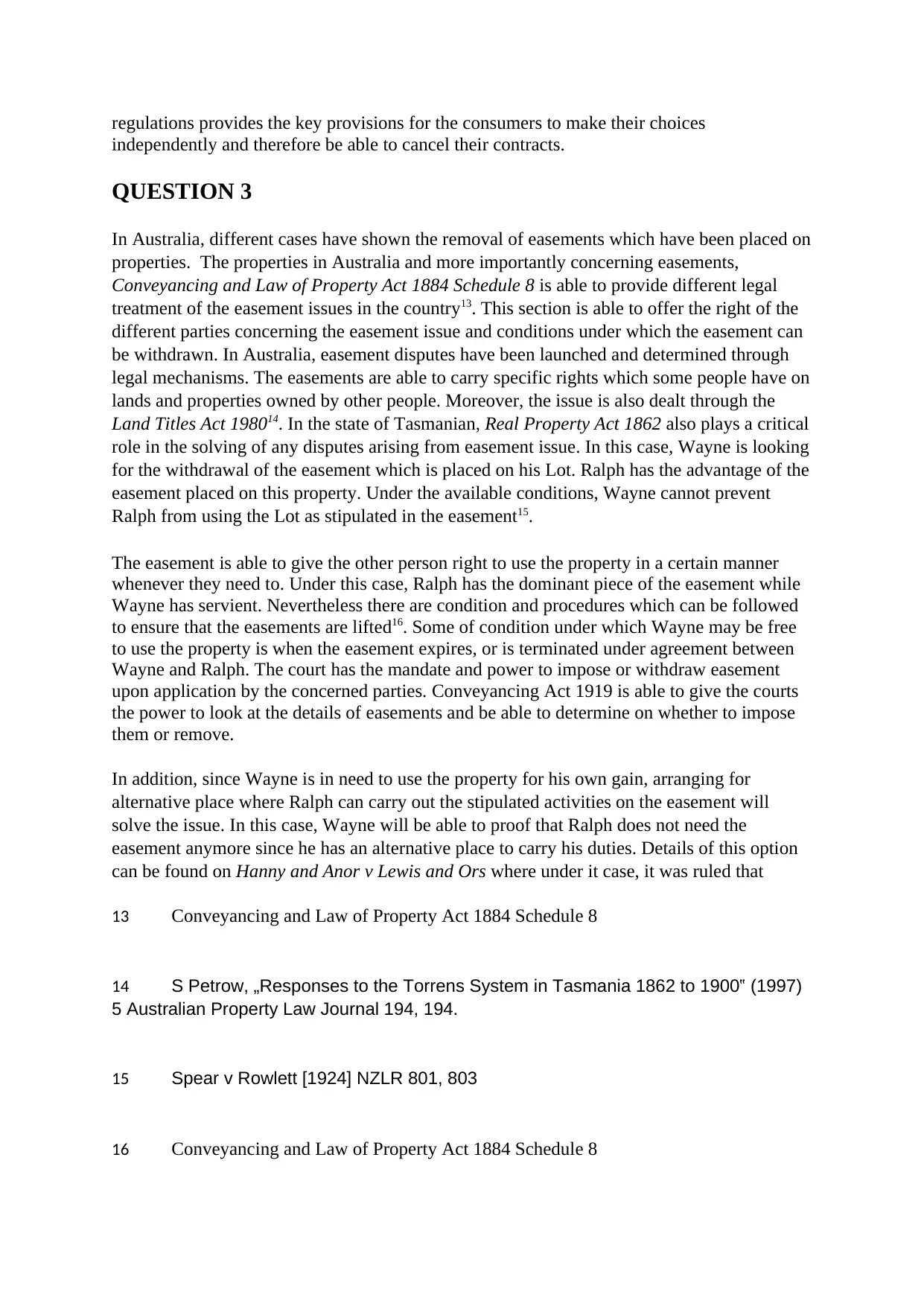
regulations provides the key provisions for the consumers to make their choices
independently and therefore be able to cancel their contracts.
QUESTION 3
In Australia, different cases have shown the removal of easements which have been placed on
properties. The properties in Australia and more importantly concerning easements,
Conveyancing and Law of Property Act 1884 Schedule 8 is able to provide different legal
treatment of the easement issues in the country13. This section is able to offer the right of the
different parties concerning the easement issue and conditions under which the easement can
be withdrawn. In Australia, easement disputes have been launched and determined through
legal mechanisms. The easements are able to carry specific rights which some people have on
lands and properties owned by other people. Moreover, the issue is also dealt through the
Land Titles Act 198014. In the state of Tasmanian, Real Property Act 1862 also plays a critical
role in the solving of any disputes arising from easement issue. In this case, Wayne is looking
for the withdrawal of the easement which is placed on his Lot. Ralph has the advantage of the
easement placed on this property. Under the available conditions, Wayne cannot prevent
Ralph from using the Lot as stipulated in the easement15.
The easement is able to give the other person right to use the property in a certain manner
whenever they need to. Under this case, Ralph has the dominant piece of the easement while
Wayne has servient. Nevertheless there are condition and procedures which can be followed
to ensure that the easements are lifted16. Some of condition under which Wayne may be free
to use the property is when the easement expires, or is terminated under agreement between
Wayne and Ralph. The court has the mandate and power to impose or withdraw easement
upon application by the concerned parties. Conveyancing Act 1919 is able to give the courts
the power to look at the details of easements and be able to determine on whether to impose
them or remove.
In addition, since Wayne is in need to use the property for his own gain, arranging for
alternative place where Ralph can carry out the stipulated activities on the easement will
solve the issue. In this case, Wayne will be able to proof that Ralph does not need the
easement anymore since he has an alternative place to carry his duties. Details of this option
can be found on Hanny and Anor v Lewis and Ors where under it case, it was ruled that
13 Conveyancing and Law of Property Act 1884 Schedule 8
14 S Petrow, „Responses to the Torrens System in Tasmania 1862 to 1900‟ (1997)
5 Australian Property Law Journal 194, 194.
15 Spear v Rowlett [1924] NZLR 801, 803
16 Conveyancing and Law of Property Act 1884 Schedule 8
independently and therefore be able to cancel their contracts.
QUESTION 3
In Australia, different cases have shown the removal of easements which have been placed on
properties. The properties in Australia and more importantly concerning easements,
Conveyancing and Law of Property Act 1884 Schedule 8 is able to provide different legal
treatment of the easement issues in the country13. This section is able to offer the right of the
different parties concerning the easement issue and conditions under which the easement can
be withdrawn. In Australia, easement disputes have been launched and determined through
legal mechanisms. The easements are able to carry specific rights which some people have on
lands and properties owned by other people. Moreover, the issue is also dealt through the
Land Titles Act 198014. In the state of Tasmanian, Real Property Act 1862 also plays a critical
role in the solving of any disputes arising from easement issue. In this case, Wayne is looking
for the withdrawal of the easement which is placed on his Lot. Ralph has the advantage of the
easement placed on this property. Under the available conditions, Wayne cannot prevent
Ralph from using the Lot as stipulated in the easement15.
The easement is able to give the other person right to use the property in a certain manner
whenever they need to. Under this case, Ralph has the dominant piece of the easement while
Wayne has servient. Nevertheless there are condition and procedures which can be followed
to ensure that the easements are lifted16. Some of condition under which Wayne may be free
to use the property is when the easement expires, or is terminated under agreement between
Wayne and Ralph. The court has the mandate and power to impose or withdraw easement
upon application by the concerned parties. Conveyancing Act 1919 is able to give the courts
the power to look at the details of easements and be able to determine on whether to impose
them or remove.
In addition, since Wayne is in need to use the property for his own gain, arranging for
alternative place where Ralph can carry out the stipulated activities on the easement will
solve the issue. In this case, Wayne will be able to proof that Ralph does not need the
easement anymore since he has an alternative place to carry his duties. Details of this option
can be found on Hanny and Anor v Lewis and Ors where under it case, it was ruled that
13 Conveyancing and Law of Property Act 1884 Schedule 8
14 S Petrow, „Responses to the Torrens System in Tasmania 1862 to 1900‟ (1997)
5 Australian Property Law Journal 194, 194.
15 Spear v Rowlett [1924] NZLR 801, 803
16 Conveyancing and Law of Property Act 1884 Schedule 8
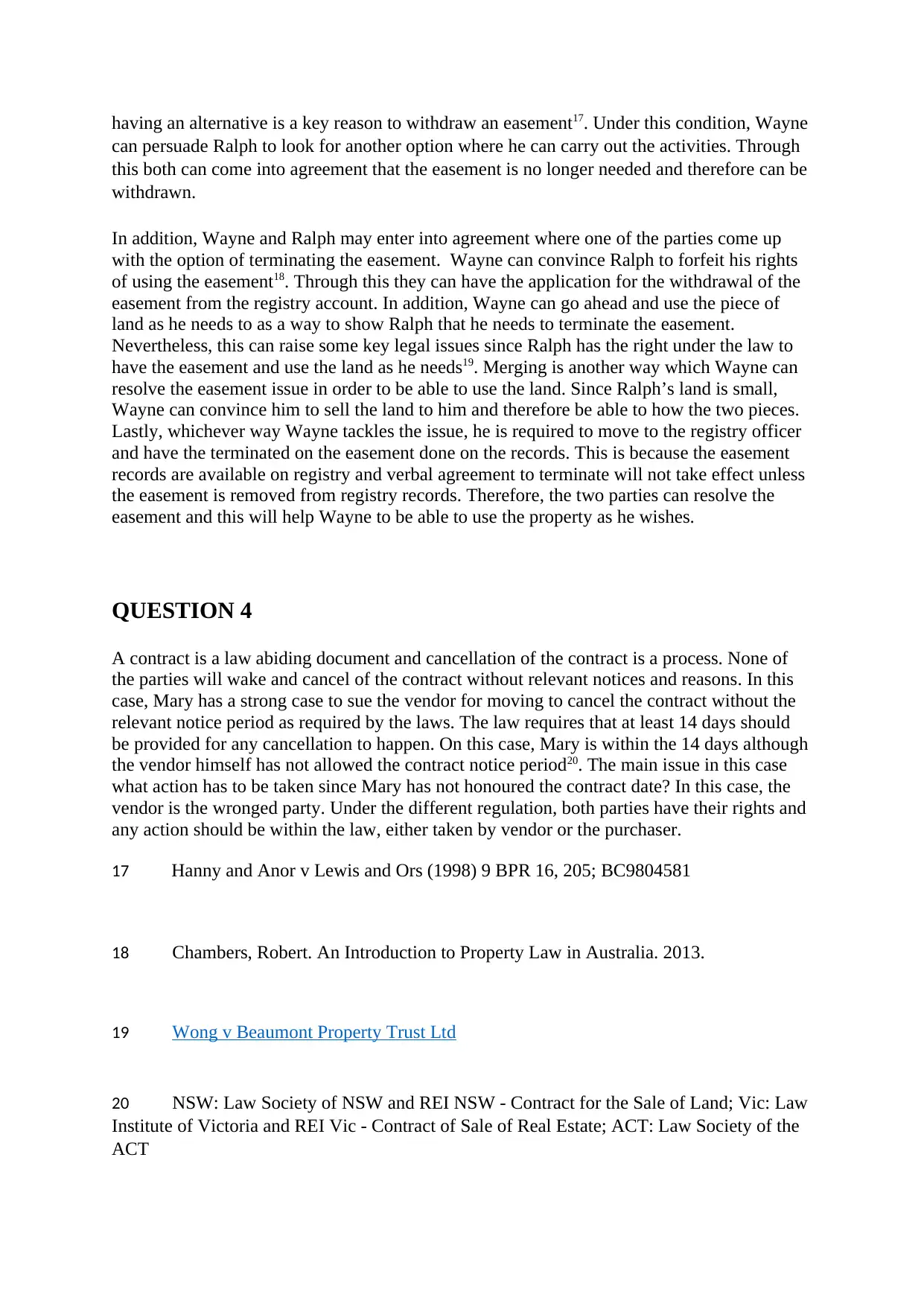
having an alternative is a key reason to withdraw an easement17. Under this condition, Wayne
can persuade Ralph to look for another option where he can carry out the activities. Through
this both can come into agreement that the easement is no longer needed and therefore can be
withdrawn.
In addition, Wayne and Ralph may enter into agreement where one of the parties come up
with the option of terminating the easement. Wayne can convince Ralph to forfeit his rights
of using the easement18. Through this they can have the application for the withdrawal of the
easement from the registry account. In addition, Wayne can go ahead and use the piece of
land as he needs to as a way to show Ralph that he needs to terminate the easement.
Nevertheless, this can raise some key legal issues since Ralph has the right under the law to
have the easement and use the land as he needs19. Merging is another way which Wayne can
resolve the easement issue in order to be able to use the land. Since Ralph’s land is small,
Wayne can convince him to sell the land to him and therefore be able to how the two pieces.
Lastly, whichever way Wayne tackles the issue, he is required to move to the registry officer
and have the terminated on the easement done on the records. This is because the easement
records are available on registry and verbal agreement to terminate will not take effect unless
the easement is removed from registry records. Therefore, the two parties can resolve the
easement and this will help Wayne to be able to use the property as he wishes.
QUESTION 4
A contract is a law abiding document and cancellation of the contract is a process. None of
the parties will wake and cancel of the contract without relevant notices and reasons. In this
case, Mary has a strong case to sue the vendor for moving to cancel the contract without the
relevant notice period as required by the laws. The law requires that at least 14 days should
be provided for any cancellation to happen. On this case, Mary is within the 14 days although
the vendor himself has not allowed the contract notice period20. The main issue in this case
what action has to be taken since Mary has not honoured the contract date? In this case, the
vendor is the wronged party. Under the different regulation, both parties have their rights and
any action should be within the law, either taken by vendor or the purchaser.
17 Hanny and Anor v Lewis and Ors (1998) 9 BPR 16, 205; BC9804581
18 Chambers, Robert. An Introduction to Property Law in Australia. 2013.
19 Wong v Beaumont Property Trust Ltd
20 NSW: Law Society of NSW and REI NSW - Contract for the Sale of Land; Vic: Law
Institute of Victoria and REI Vic - Contract of Sale of Real Estate; ACT: Law Society of the
ACT
can persuade Ralph to look for another option where he can carry out the activities. Through
this both can come into agreement that the easement is no longer needed and therefore can be
withdrawn.
In addition, Wayne and Ralph may enter into agreement where one of the parties come up
with the option of terminating the easement. Wayne can convince Ralph to forfeit his rights
of using the easement18. Through this they can have the application for the withdrawal of the
easement from the registry account. In addition, Wayne can go ahead and use the piece of
land as he needs to as a way to show Ralph that he needs to terminate the easement.
Nevertheless, this can raise some key legal issues since Ralph has the right under the law to
have the easement and use the land as he needs19. Merging is another way which Wayne can
resolve the easement issue in order to be able to use the land. Since Ralph’s land is small,
Wayne can convince him to sell the land to him and therefore be able to how the two pieces.
Lastly, whichever way Wayne tackles the issue, he is required to move to the registry officer
and have the terminated on the easement done on the records. This is because the easement
records are available on registry and verbal agreement to terminate will not take effect unless
the easement is removed from registry records. Therefore, the two parties can resolve the
easement and this will help Wayne to be able to use the property as he wishes.
QUESTION 4
A contract is a law abiding document and cancellation of the contract is a process. None of
the parties will wake and cancel of the contract without relevant notices and reasons. In this
case, Mary has a strong case to sue the vendor for moving to cancel the contract without the
relevant notice period as required by the laws. The law requires that at least 14 days should
be provided for any cancellation to happen. On this case, Mary is within the 14 days although
the vendor himself has not allowed the contract notice period20. The main issue in this case
what action has to be taken since Mary has not honoured the contract date? In this case, the
vendor is the wronged party. Under the different regulation, both parties have their rights and
any action should be within the law, either taken by vendor or the purchaser.
17 Hanny and Anor v Lewis and Ors (1998) 9 BPR 16, 205; BC9804581
18 Chambers, Robert. An Introduction to Property Law in Australia. 2013.
19 Wong v Beaumont Property Trust Ltd
20 NSW: Law Society of NSW and REI NSW - Contract for the Sale of Land; Vic: Law
Institute of Victoria and REI Vic - Contract of Sale of Real Estate; ACT: Law Society of the
ACT
⊘ This is a preview!⊘
Do you want full access?
Subscribe today to unlock all pages.

Trusted by 1+ million students worldwide
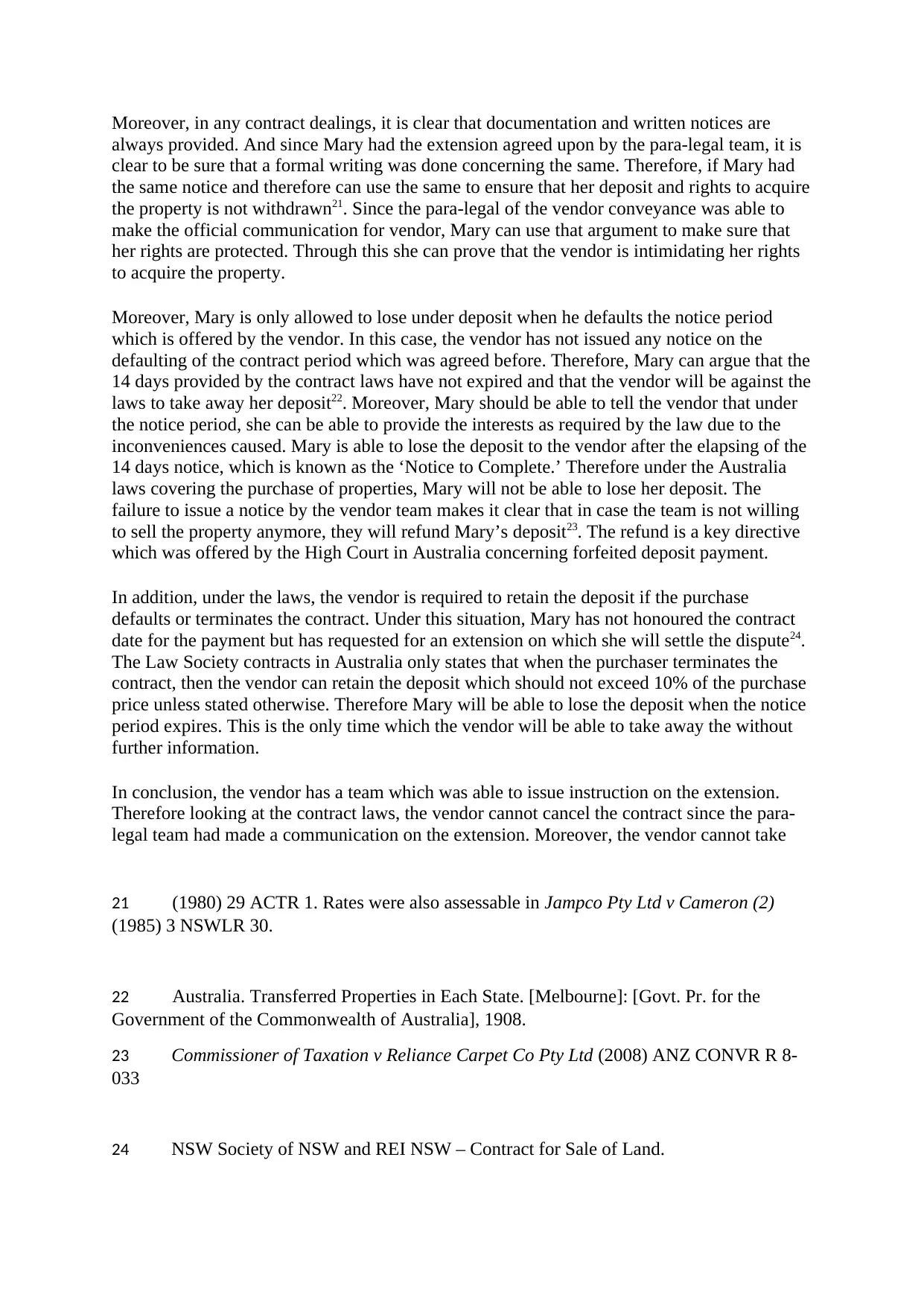
Moreover, in any contract dealings, it is clear that documentation and written notices are
always provided. And since Mary had the extension agreed upon by the para-legal team, it is
clear to be sure that a formal writing was done concerning the same. Therefore, if Mary had
the same notice and therefore can use the same to ensure that her deposit and rights to acquire
the property is not withdrawn21. Since the para-legal of the vendor conveyance was able to
make the official communication for vendor, Mary can use that argument to make sure that
her rights are protected. Through this she can prove that the vendor is intimidating her rights
to acquire the property.
Moreover, Mary is only allowed to lose under deposit when he defaults the notice period
which is offered by the vendor. In this case, the vendor has not issued any notice on the
defaulting of the contract period which was agreed before. Therefore, Mary can argue that the
14 days provided by the contract laws have not expired and that the vendor will be against the
laws to take away her deposit22. Moreover, Mary should be able to tell the vendor that under
the notice period, she can be able to provide the interests as required by the law due to the
inconveniences caused. Mary is able to lose the deposit to the vendor after the elapsing of the
14 days notice, which is known as the ‘Notice to Complete.’ Therefore under the Australia
laws covering the purchase of properties, Mary will not be able to lose her deposit. The
failure to issue a notice by the vendor team makes it clear that in case the team is not willing
to sell the property anymore, they will refund Mary’s deposit23. The refund is a key directive
which was offered by the High Court in Australia concerning forfeited deposit payment.
In addition, under the laws, the vendor is required to retain the deposit if the purchase
defaults or terminates the contract. Under this situation, Mary has not honoured the contract
date for the payment but has requested for an extension on which she will settle the dispute24.
The Law Society contracts in Australia only states that when the purchaser terminates the
contract, then the vendor can retain the deposit which should not exceed 10% of the purchase
price unless stated otherwise. Therefore Mary will be able to lose the deposit when the notice
period expires. This is the only time which the vendor will be able to take away the without
further information.
In conclusion, the vendor has a team which was able to issue instruction on the extension.
Therefore looking at the contract laws, the vendor cannot cancel the contract since the para-
legal team had made a communication on the extension. Moreover, the vendor cannot take
21 (1980) 29 ACTR 1. Rates were also assessable in Jampco Pty Ltd v Cameron (2)
(1985) 3 NSWLR 30.
22 Australia. Transferred Properties in Each State. [Melbourne]: [Govt. Pr. for the
Government of the Commonwealth of Australia], 1908.
23 Commissioner of Taxation v Reliance Carpet Co Pty Ltd (2008) ANZ CONVR R 8-
033
24 NSW Society of NSW and REI NSW – Contract for Sale of Land.
always provided. And since Mary had the extension agreed upon by the para-legal team, it is
clear to be sure that a formal writing was done concerning the same. Therefore, if Mary had
the same notice and therefore can use the same to ensure that her deposit and rights to acquire
the property is not withdrawn21. Since the para-legal of the vendor conveyance was able to
make the official communication for vendor, Mary can use that argument to make sure that
her rights are protected. Through this she can prove that the vendor is intimidating her rights
to acquire the property.
Moreover, Mary is only allowed to lose under deposit when he defaults the notice period
which is offered by the vendor. In this case, the vendor has not issued any notice on the
defaulting of the contract period which was agreed before. Therefore, Mary can argue that the
14 days provided by the contract laws have not expired and that the vendor will be against the
laws to take away her deposit22. Moreover, Mary should be able to tell the vendor that under
the notice period, she can be able to provide the interests as required by the law due to the
inconveniences caused. Mary is able to lose the deposit to the vendor after the elapsing of the
14 days notice, which is known as the ‘Notice to Complete.’ Therefore under the Australia
laws covering the purchase of properties, Mary will not be able to lose her deposit. The
failure to issue a notice by the vendor team makes it clear that in case the team is not willing
to sell the property anymore, they will refund Mary’s deposit23. The refund is a key directive
which was offered by the High Court in Australia concerning forfeited deposit payment.
In addition, under the laws, the vendor is required to retain the deposit if the purchase
defaults or terminates the contract. Under this situation, Mary has not honoured the contract
date for the payment but has requested for an extension on which she will settle the dispute24.
The Law Society contracts in Australia only states that when the purchaser terminates the
contract, then the vendor can retain the deposit which should not exceed 10% of the purchase
price unless stated otherwise. Therefore Mary will be able to lose the deposit when the notice
period expires. This is the only time which the vendor will be able to take away the without
further information.
In conclusion, the vendor has a team which was able to issue instruction on the extension.
Therefore looking at the contract laws, the vendor cannot cancel the contract since the para-
legal team had made a communication on the extension. Moreover, the vendor cannot take
21 (1980) 29 ACTR 1. Rates were also assessable in Jampco Pty Ltd v Cameron (2)
(1985) 3 NSWLR 30.
22 Australia. Transferred Properties in Each State. [Melbourne]: [Govt. Pr. for the
Government of the Commonwealth of Australia], 1908.
23 Commissioner of Taxation v Reliance Carpet Co Pty Ltd (2008) ANZ CONVR R 8-
033
24 NSW Society of NSW and REI NSW – Contract for Sale of Land.
Paraphrase This Document
Need a fresh take? Get an instant paraphrase of this document with our AI Paraphraser
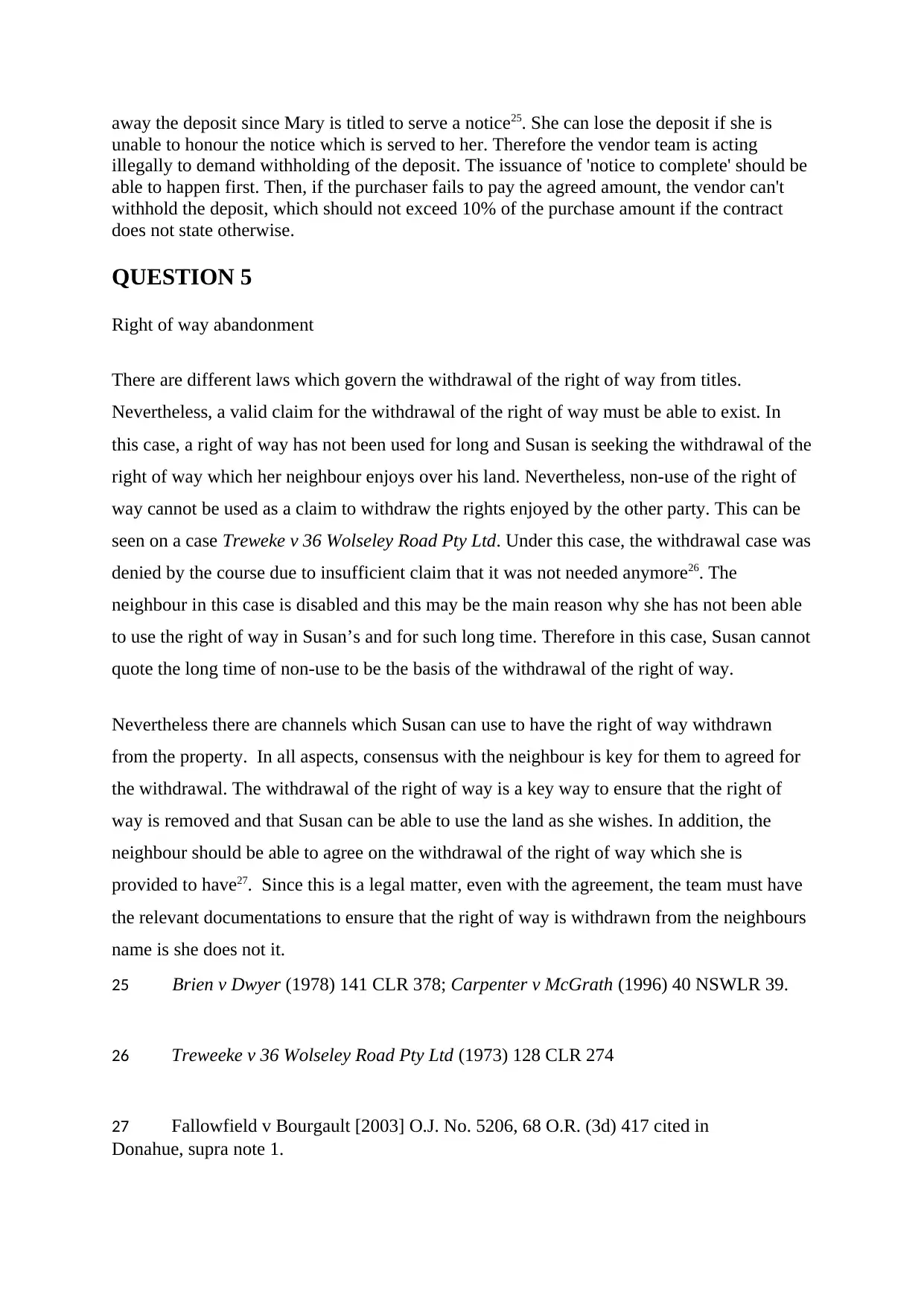
away the deposit since Mary is titled to serve a notice25. She can lose the deposit if she is
unable to honour the notice which is served to her. Therefore the vendor team is acting
illegally to demand withholding of the deposit. The issuance of 'notice to complete' should be
able to happen first. Then, if the purchaser fails to pay the agreed amount, the vendor can't
withhold the deposit, which should not exceed 10% of the purchase amount if the contract
does not state otherwise.
QUESTION 5
Right of way abandonment
There are different laws which govern the withdrawal of the right of way from titles.
Nevertheless, a valid claim for the withdrawal of the right of way must be able to exist. In
this case, a right of way has not been used for long and Susan is seeking the withdrawal of the
right of way which her neighbour enjoys over his land. Nevertheless, non-use of the right of
way cannot be used as a claim to withdraw the rights enjoyed by the other party. This can be
seen on a case Treweke v 36 Wolseley Road Pty Ltd. Under this case, the withdrawal case was
denied by the course due to insufficient claim that it was not needed anymore26. The
neighbour in this case is disabled and this may be the main reason why she has not been able
to use the right of way in Susan’s and for such long time. Therefore in this case, Susan cannot
quote the long time of non-use to be the basis of the withdrawal of the right of way.
Nevertheless there are channels which Susan can use to have the right of way withdrawn
from the property. In all aspects, consensus with the neighbour is key for them to agreed for
the withdrawal. The withdrawal of the right of way is a key way to ensure that the right of
way is removed and that Susan can be able to use the land as she wishes. In addition, the
neighbour should be able to agree on the withdrawal of the right of way which she is
provided to have27. Since this is a legal matter, even with the agreement, the team must have
the relevant documentations to ensure that the right of way is withdrawn from the neighbours
name is she does not it.
25 Brien v Dwyer (1978) 141 CLR 378; Carpenter v McGrath (1996) 40 NSWLR 39.
26 Treweeke v 36 Wolseley Road Pty Ltd (1973) 128 CLR 274
27 Fallowfield v Bourgault [2003] O.J. No. 5206, 68 O.R. (3d) 417 cited in
Donahue, supra note 1.
unable to honour the notice which is served to her. Therefore the vendor team is acting
illegally to demand withholding of the deposit. The issuance of 'notice to complete' should be
able to happen first. Then, if the purchaser fails to pay the agreed amount, the vendor can't
withhold the deposit, which should not exceed 10% of the purchase amount if the contract
does not state otherwise.
QUESTION 5
Right of way abandonment
There are different laws which govern the withdrawal of the right of way from titles.
Nevertheless, a valid claim for the withdrawal of the right of way must be able to exist. In
this case, a right of way has not been used for long and Susan is seeking the withdrawal of the
right of way which her neighbour enjoys over his land. Nevertheless, non-use of the right of
way cannot be used as a claim to withdraw the rights enjoyed by the other party. This can be
seen on a case Treweke v 36 Wolseley Road Pty Ltd. Under this case, the withdrawal case was
denied by the course due to insufficient claim that it was not needed anymore26. The
neighbour in this case is disabled and this may be the main reason why she has not been able
to use the right of way in Susan’s and for such long time. Therefore in this case, Susan cannot
quote the long time of non-use to be the basis of the withdrawal of the right of way.
Nevertheless there are channels which Susan can use to have the right of way withdrawn
from the property. In all aspects, consensus with the neighbour is key for them to agreed for
the withdrawal. The withdrawal of the right of way is a key way to ensure that the right of
way is removed and that Susan can be able to use the land as she wishes. In addition, the
neighbour should be able to agree on the withdrawal of the right of way which she is
provided to have27. Since this is a legal matter, even with the agreement, the team must have
the relevant documentations to ensure that the right of way is withdrawn from the neighbours
name is she does not it.
25 Brien v Dwyer (1978) 141 CLR 378; Carpenter v McGrath (1996) 40 NSWLR 39.
26 Treweeke v 36 Wolseley Road Pty Ltd (1973) 128 CLR 274
27 Fallowfield v Bourgault [2003] O.J. No. 5206, 68 O.R. (3d) 417 cited in
Donahue, supra note 1.
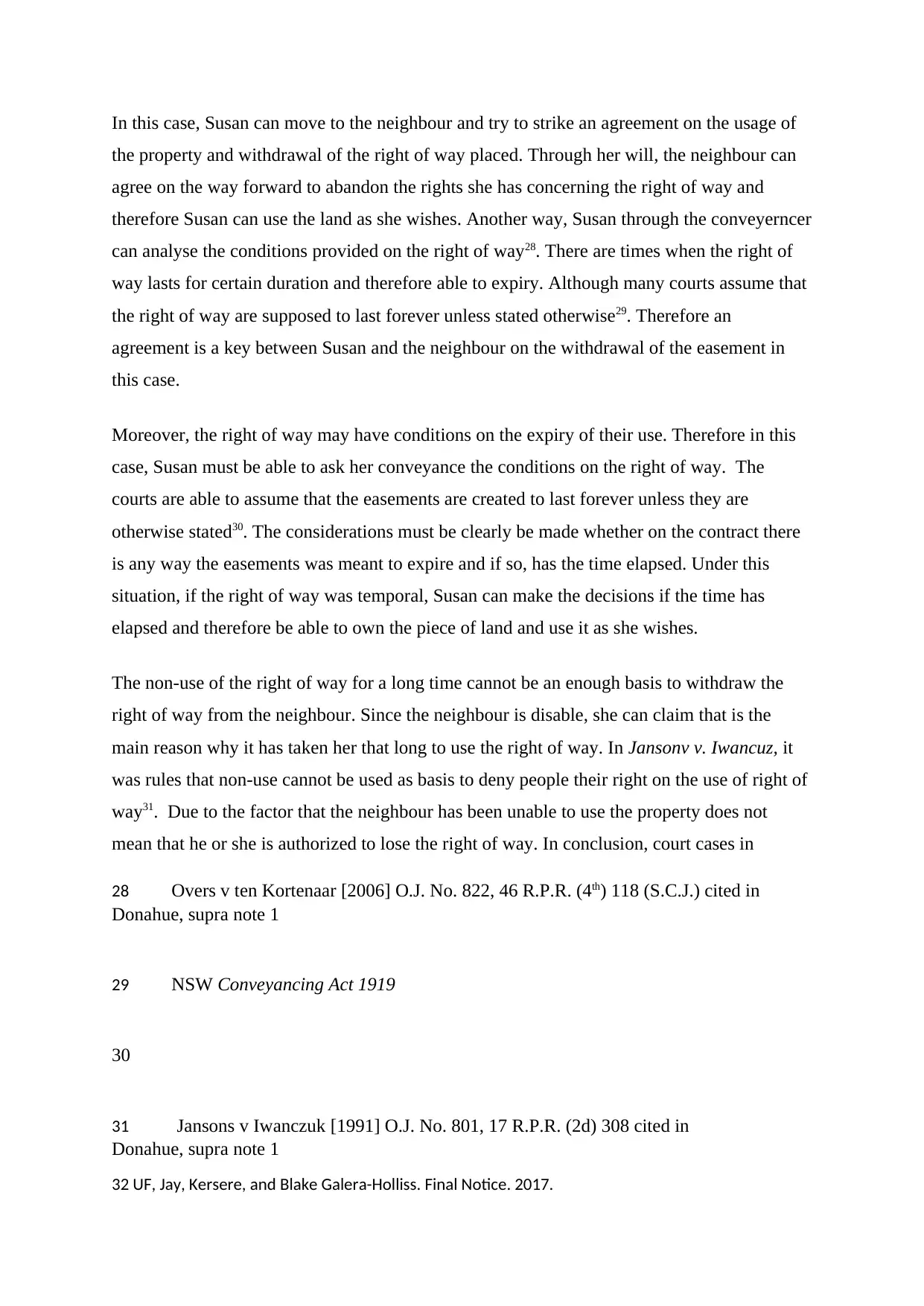
In this case, Susan can move to the neighbour and try to strike an agreement on the usage of
the property and withdrawal of the right of way placed. Through her will, the neighbour can
agree on the way forward to abandon the rights she has concerning the right of way and
therefore Susan can use the land as she wishes. Another way, Susan through the conveyerncer
can analyse the conditions provided on the right of way28. There are times when the right of
way lasts for certain duration and therefore able to expiry. Although many courts assume that
the right of way are supposed to last forever unless stated otherwise29. Therefore an
agreement is a key between Susan and the neighbour on the withdrawal of the easement in
this case.
Moreover, the right of way may have conditions on the expiry of their use. Therefore in this
case, Susan must be able to ask her conveyance the conditions on the right of way. The
courts are able to assume that the easements are created to last forever unless they are
otherwise stated30. The considerations must be clearly be made whether on the contract there
is any way the easements was meant to expire and if so, has the time elapsed. Under this
situation, if the right of way was temporal, Susan can make the decisions if the time has
elapsed and therefore be able to own the piece of land and use it as she wishes.
The non-use of the right of way for a long time cannot be an enough basis to withdraw the
right of way from the neighbour. Since the neighbour is disable, she can claim that is the
main reason why it has taken her that long to use the right of way. In Jansonv v. Iwancuz, it
was rules that non-use cannot be used as basis to deny people their right on the use of right of
way31. Due to the factor that the neighbour has been unable to use the property does not
mean that he or she is authorized to lose the right of way. In conclusion, court cases in
28 Overs v ten Kortenaar [2006] O.J. No. 822, 46 R.P.R. (4th) 118 (S.C.J.) cited in
Donahue, supra note 1
29 NSW Conveyancing Act 1919
30
31 Jansons v Iwanczuk [1991] O.J. No. 801, 17 R.P.R. (2d) 308 cited in
Donahue, supra note 1
32 UF, Jay, Kersere, and Blake Galera-Holliss. Final Notice. 2017.
the property and withdrawal of the right of way placed. Through her will, the neighbour can
agree on the way forward to abandon the rights she has concerning the right of way and
therefore Susan can use the land as she wishes. Another way, Susan through the conveyerncer
can analyse the conditions provided on the right of way28. There are times when the right of
way lasts for certain duration and therefore able to expiry. Although many courts assume that
the right of way are supposed to last forever unless stated otherwise29. Therefore an
agreement is a key between Susan and the neighbour on the withdrawal of the easement in
this case.
Moreover, the right of way may have conditions on the expiry of their use. Therefore in this
case, Susan must be able to ask her conveyance the conditions on the right of way. The
courts are able to assume that the easements are created to last forever unless they are
otherwise stated30. The considerations must be clearly be made whether on the contract there
is any way the easements was meant to expire and if so, has the time elapsed. Under this
situation, if the right of way was temporal, Susan can make the decisions if the time has
elapsed and therefore be able to own the piece of land and use it as she wishes.
The non-use of the right of way for a long time cannot be an enough basis to withdraw the
right of way from the neighbour. Since the neighbour is disable, she can claim that is the
main reason why it has taken her that long to use the right of way. In Jansonv v. Iwancuz, it
was rules that non-use cannot be used as basis to deny people their right on the use of right of
way31. Due to the factor that the neighbour has been unable to use the property does not
mean that he or she is authorized to lose the right of way. In conclusion, court cases in
28 Overs v ten Kortenaar [2006] O.J. No. 822, 46 R.P.R. (4th) 118 (S.C.J.) cited in
Donahue, supra note 1
29 NSW Conveyancing Act 1919
30
31 Jansons v Iwanczuk [1991] O.J. No. 801, 17 R.P.R. (2d) 308 cited in
Donahue, supra note 1
32 UF, Jay, Kersere, and Blake Galera-Holliss. Final Notice. 2017.
⊘ This is a preview!⊘
Do you want full access?
Subscribe today to unlock all pages.

Trusted by 1+ million students worldwide
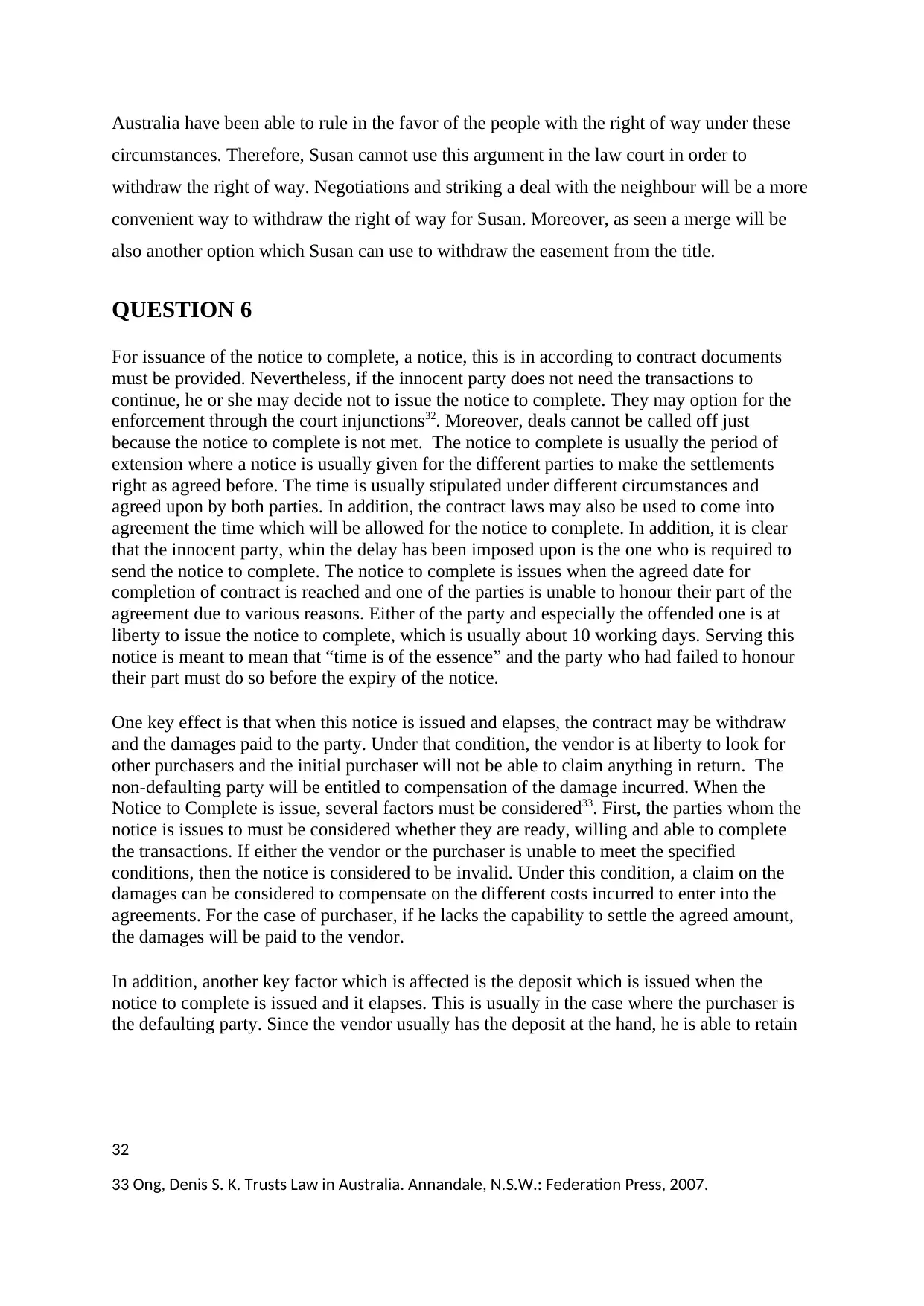
Australia have been able to rule in the favor of the people with the right of way under these
circumstances. Therefore, Susan cannot use this argument in the law court in order to
withdraw the right of way. Negotiations and striking a deal with the neighbour will be a more
convenient way to withdraw the right of way for Susan. Moreover, as seen a merge will be
also another option which Susan can use to withdraw the easement from the title.
QUESTION 6
For issuance of the notice to complete, a notice, this is in according to contract documents
must be provided. Nevertheless, if the innocent party does not need the transactions to
continue, he or she may decide not to issue the notice to complete. They may option for the
enforcement through the court injunctions32. Moreover, deals cannot be called off just
because the notice to complete is not met. The notice to complete is usually the period of
extension where a notice is usually given for the different parties to make the settlements
right as agreed before. The time is usually stipulated under different circumstances and
agreed upon by both parties. In addition, the contract laws may also be used to come into
agreement the time which will be allowed for the notice to complete. In addition, it is clear
that the innocent party, whin the delay has been imposed upon is the one who is required to
send the notice to complete. The notice to complete is issues when the agreed date for
completion of contract is reached and one of the parties is unable to honour their part of the
agreement due to various reasons. Either of the party and especially the offended one is at
liberty to issue the notice to complete, which is usually about 10 working days. Serving this
notice is meant to mean that “time is of the essence” and the party who had failed to honour
their part must do so before the expiry of the notice.
One key effect is that when this notice is issued and elapses, the contract may be withdraw
and the damages paid to the party. Under that condition, the vendor is at liberty to look for
other purchasers and the initial purchaser will not be able to claim anything in return. The
non-defaulting party will be entitled to compensation of the damage incurred. When the
Notice to Complete is issue, several factors must be considered33. First, the parties whom the
notice is issues to must be considered whether they are ready, willing and able to complete
the transactions. If either the vendor or the purchaser is unable to meet the specified
conditions, then the notice is considered to be invalid. Under this condition, a claim on the
damages can be considered to compensate on the different costs incurred to enter into the
agreements. For the case of purchaser, if he lacks the capability to settle the agreed amount,
the damages will be paid to the vendor.
In addition, another key factor which is affected is the deposit which is issued when the
notice to complete is issued and it elapses. This is usually in the case where the purchaser is
the defaulting party. Since the vendor usually has the deposit at the hand, he is able to retain
32
33 Ong, Denis S. K. Trusts Law in Australia. Annandale, N.S.W.: Federation Press, 2007.
circumstances. Therefore, Susan cannot use this argument in the law court in order to
withdraw the right of way. Negotiations and striking a deal with the neighbour will be a more
convenient way to withdraw the right of way for Susan. Moreover, as seen a merge will be
also another option which Susan can use to withdraw the easement from the title.
QUESTION 6
For issuance of the notice to complete, a notice, this is in according to contract documents
must be provided. Nevertheless, if the innocent party does not need the transactions to
continue, he or she may decide not to issue the notice to complete. They may option for the
enforcement through the court injunctions32. Moreover, deals cannot be called off just
because the notice to complete is not met. The notice to complete is usually the period of
extension where a notice is usually given for the different parties to make the settlements
right as agreed before. The time is usually stipulated under different circumstances and
agreed upon by both parties. In addition, the contract laws may also be used to come into
agreement the time which will be allowed for the notice to complete. In addition, it is clear
that the innocent party, whin the delay has been imposed upon is the one who is required to
send the notice to complete. The notice to complete is issues when the agreed date for
completion of contract is reached and one of the parties is unable to honour their part of the
agreement due to various reasons. Either of the party and especially the offended one is at
liberty to issue the notice to complete, which is usually about 10 working days. Serving this
notice is meant to mean that “time is of the essence” and the party who had failed to honour
their part must do so before the expiry of the notice.
One key effect is that when this notice is issued and elapses, the contract may be withdraw
and the damages paid to the party. Under that condition, the vendor is at liberty to look for
other purchasers and the initial purchaser will not be able to claim anything in return. The
non-defaulting party will be entitled to compensation of the damage incurred. When the
Notice to Complete is issue, several factors must be considered33. First, the parties whom the
notice is issues to must be considered whether they are ready, willing and able to complete
the transactions. If either the vendor or the purchaser is unable to meet the specified
conditions, then the notice is considered to be invalid. Under this condition, a claim on the
damages can be considered to compensate on the different costs incurred to enter into the
agreements. For the case of purchaser, if he lacks the capability to settle the agreed amount,
the damages will be paid to the vendor.
In addition, another key factor which is affected is the deposit which is issued when the
notice to complete is issued and it elapses. This is usually in the case where the purchaser is
the defaulting party. Since the vendor usually has the deposit at the hand, he is able to retain
32
33 Ong, Denis S. K. Trusts Law in Australia. Annandale, N.S.W.: Federation Press, 2007.
Paraphrase This Document
Need a fresh take? Get an instant paraphrase of this document with our AI Paraphraser
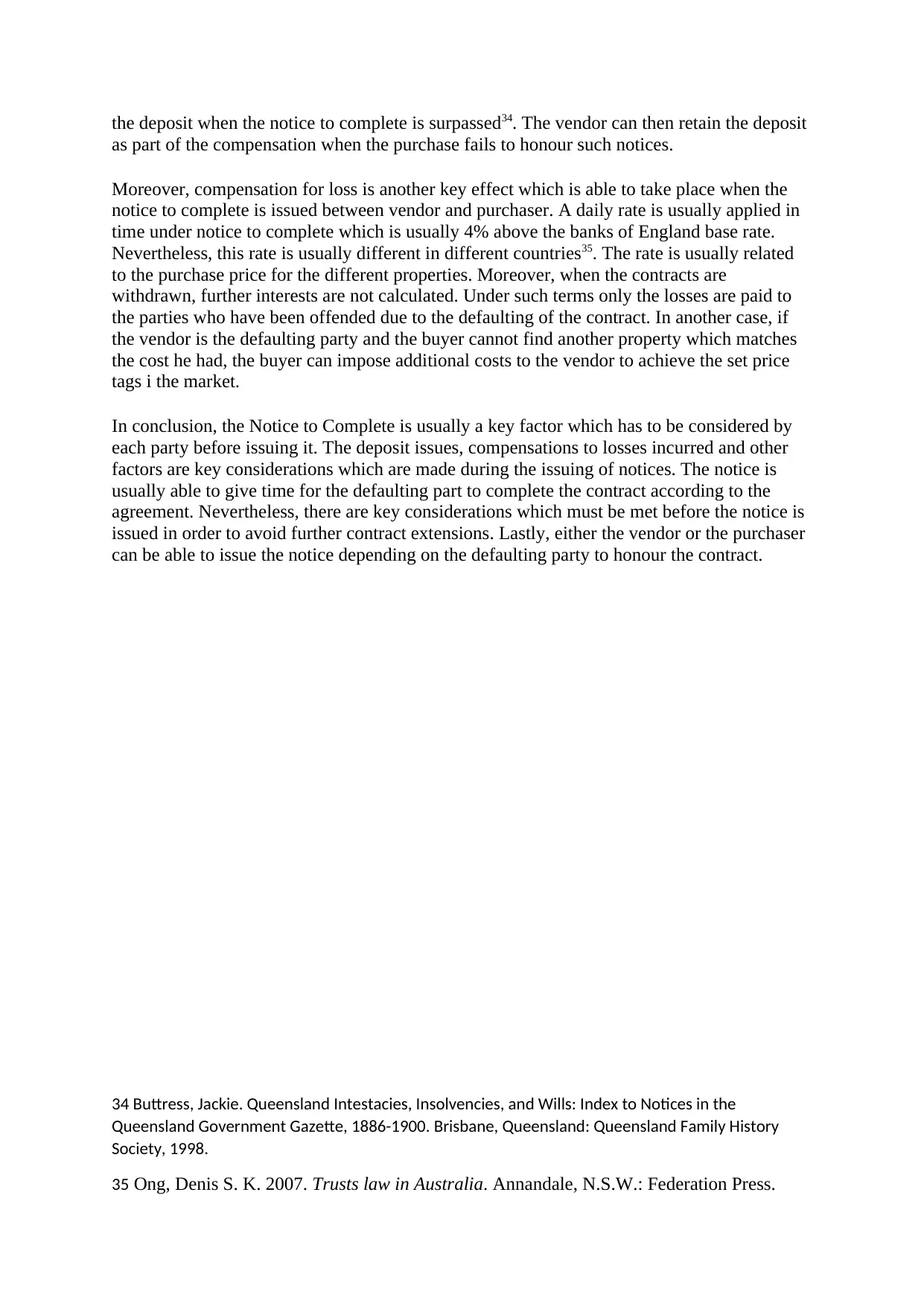
the deposit when the notice to complete is surpassed34. The vendor can then retain the deposit
as part of the compensation when the purchase fails to honour such notices.
Moreover, compensation for loss is another key effect which is able to take place when the
notice to complete is issued between vendor and purchaser. A daily rate is usually applied in
time under notice to complete which is usually 4% above the banks of England base rate.
Nevertheless, this rate is usually different in different countries35. The rate is usually related
to the purchase price for the different properties. Moreover, when the contracts are
withdrawn, further interests are not calculated. Under such terms only the losses are paid to
the parties who have been offended due to the defaulting of the contract. In another case, if
the vendor is the defaulting party and the buyer cannot find another property which matches
the cost he had, the buyer can impose additional costs to the vendor to achieve the set price
tags i the market.
In conclusion, the Notice to Complete is usually a key factor which has to be considered by
each party before issuing it. The deposit issues, compensations to losses incurred and other
factors are key considerations which are made during the issuing of notices. The notice is
usually able to give time for the defaulting part to complete the contract according to the
agreement. Nevertheless, there are key considerations which must be met before the notice is
issued in order to avoid further contract extensions. Lastly, either the vendor or the purchaser
can be able to issue the notice depending on the defaulting party to honour the contract.
34 Buttress, Jackie. Queensland Intestacies, Insolvencies, and Wills: Index to Notices in the
Queensland Government Gazette, 1886-1900. Brisbane, Queensland: Queensland Family History
Society, 1998.
35 Ong, Denis S. K. 2007. Trusts law in Australia. Annandale, N.S.W.: Federation Press.
as part of the compensation when the purchase fails to honour such notices.
Moreover, compensation for loss is another key effect which is able to take place when the
notice to complete is issued between vendor and purchaser. A daily rate is usually applied in
time under notice to complete which is usually 4% above the banks of England base rate.
Nevertheless, this rate is usually different in different countries35. The rate is usually related
to the purchase price for the different properties. Moreover, when the contracts are
withdrawn, further interests are not calculated. Under such terms only the losses are paid to
the parties who have been offended due to the defaulting of the contract. In another case, if
the vendor is the defaulting party and the buyer cannot find another property which matches
the cost he had, the buyer can impose additional costs to the vendor to achieve the set price
tags i the market.
In conclusion, the Notice to Complete is usually a key factor which has to be considered by
each party before issuing it. The deposit issues, compensations to losses incurred and other
factors are key considerations which are made during the issuing of notices. The notice is
usually able to give time for the defaulting part to complete the contract according to the
agreement. Nevertheless, there are key considerations which must be met before the notice is
issued in order to avoid further contract extensions. Lastly, either the vendor or the purchaser
can be able to issue the notice depending on the defaulting party to honour the contract.
34 Buttress, Jackie. Queensland Intestacies, Insolvencies, and Wills: Index to Notices in the
Queensland Government Gazette, 1886-1900. Brisbane, Queensland: Queensland Family History
Society, 1998.
35 Ong, Denis S. K. 2007. Trusts law in Australia. Annandale, N.S.W.: Federation Press.
1 out of 11
Related Documents
Your All-in-One AI-Powered Toolkit for Academic Success.
+13062052269
info@desklib.com
Available 24*7 on WhatsApp / Email
![[object Object]](/_next/static/media/star-bottom.7253800d.svg)
Unlock your academic potential
Copyright © 2020–2025 A2Z Services. All Rights Reserved. Developed and managed by ZUCOL.





